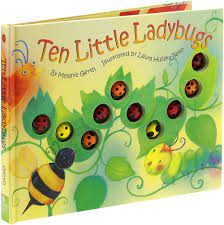
Ladybug Spots and Bedtime Numeracy
Mar 10, 2025My daughters, ages 2 and 5, go through lots of fads - sound familiar? They want to eat the same snack every day until suddenly, it falls out of favor and we are on to the next new favorite (and I try to figure out how to not waste the last third of the Costco-sized box for whatever it was). The same thing happens with bedtime books.
Recently, Janelle (5 years old) went through a period of fandom for a very cute book called Ten Little Ladybugs by Melanie Girth. It had languished on the shelf for years, and all of a sudden she picked it up and wanted to read it every night for close to two weeks.

Not having seen this book for a while, I was excited about its potential for easy numeracy work with Jonylah (Jo-NYE-lah, 2 years old). Janelle’s counting and early numeracy skills are well beyond counting up to and back from 10, but Jonylah is at the perfect stage for interacting with the number sequence going backwards.
But Janelle had picked this book, and her book pics are sacred, so off we went reading Ten Little Ladybugs bedtime after bedtime.
Maybe ten days into this streak, she stopped on a page and asked:
“How many spots are on the ladybugs?”
What a delightful mathematical question, and a beautiful opportunity to capitalize on Janelle’s natural curiosity! I strongly believe these moments are best - when a child asks the question themselves, there’s an internal motivation to figure out the answer. I see it as my job to see if there are any skills she needs to learn on the journey to answering her question.
Janelle went with an approach of counting one-by-one. It’s not very we’ve stumbled upon a natural opportunity to count so high, and it was fascinating to watch. About halfway through I managed to get a video started. Take 30 seconds to watch it: CLICK HERE!
Did you catch when she said “twenty-nine, twenty-ten” and then stopped to correct herself? And when she lost track of her count in the thirties, and ended up getting off by one on the second-to-last ladybug? She counted 41; my count looking back at the page is 42. Despite this mistake, let’s look at some of the early numeracy skills going on here.
This is a great demonstration of one-to-one correspondence (the principle that we say one count for each individual object), and how it’s tougher to keep track of a count when the thing you’re counting is randomly arranged.
Janelle also shows us that she has a grasp of the principle of cardinality - when she finishes her count, she reiterates that there are 41. This developmental milestone typically happens in the 3-5 age range. Children who haven’t yet reached this understanding will restart their count if you ask them how many objects there are, even if they’ve just finished counting.
This is one of those skills that feels beyond obvious in adulthood - I doubt any of us remember what it’s like to not yet have mastered this principle! Yet cardinality marks a significant step in mathematical learning and is a prerequisite for understanding the operations of addition and subtraction.


